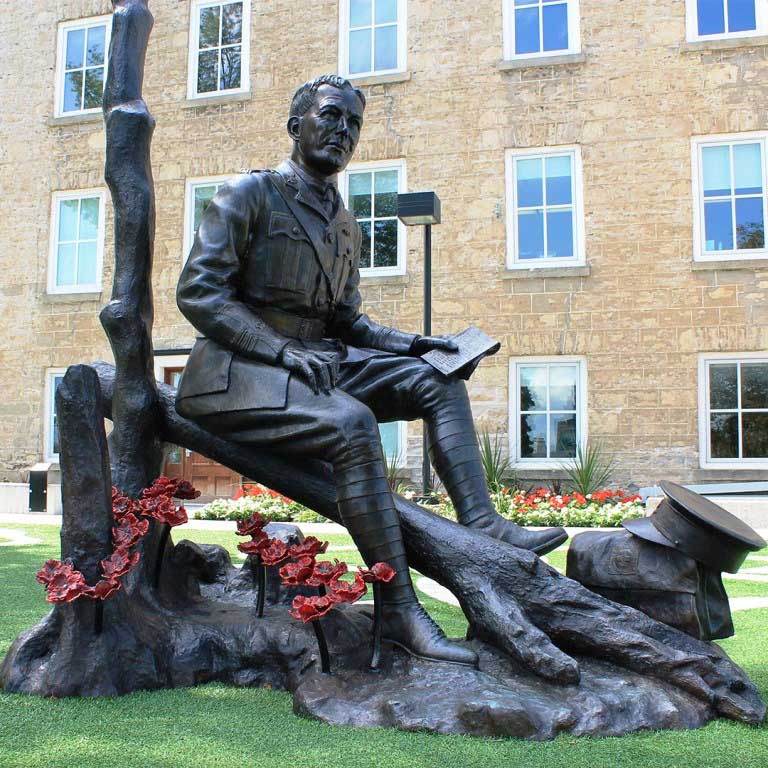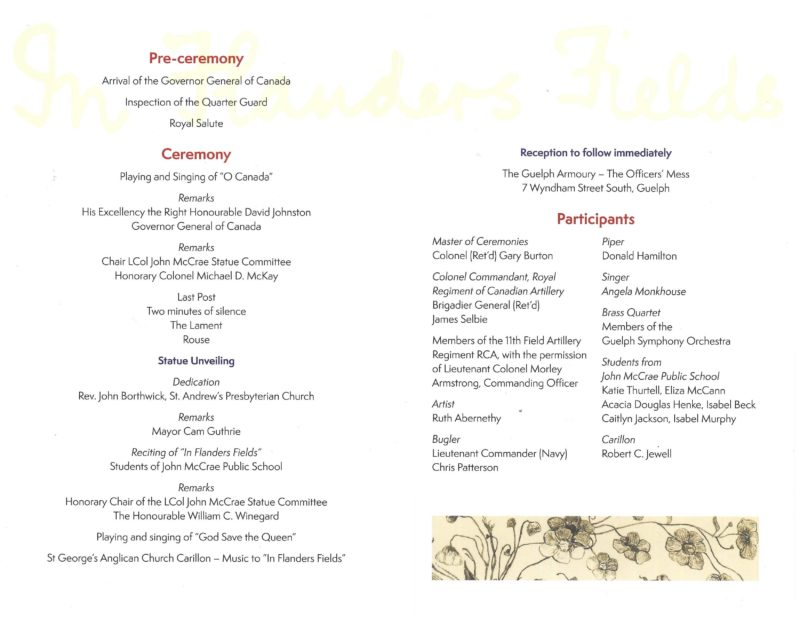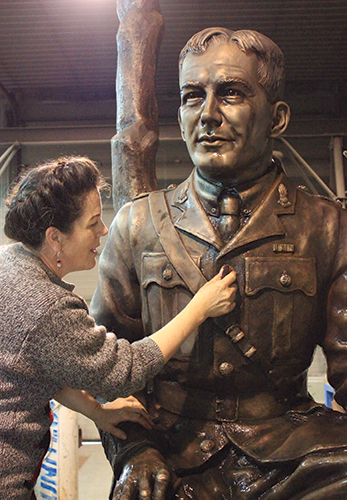Artist: Ruth Abernethy
Category: Memorial, Outdoor Art, Permanent, Sculpture, Statue
Materials: Bronze
Year: 2015
Guelph-born Lieutenant-Colonel John McCrae was an artillery officer, physician and poet, who wrote “In Flanders Fields” at the height of Second Ypres, one of the most bitter battles of World War I.
Two identical bronze statues of John McCrae were created for the centennial anniversary of the writing of his famous poem. One sits in front of the National Artillery Memorial in Ottawa, and one, unveiled by Canadian Governor General David Johnston on June 25, 2015, a month after the national statue was unveiled in Ottawa, sits atop the hill at the Guelph Civic Museum overlooking the city.

Remember Flanders, Ruth Abernethy, 2015
To honour McCrae and his poem, written May 3, 1915, the Royal Regiment of Canadian Artillery commissioned Canadian sculptor, Ruth Abernethy, to create two hand-sculpted figures. The poem, In Flanders Fields, sits in his hand while his cap rests on his medical bag in front of him. Twenty-three poppies adorn the base of the sculpture, marking each of Canada’s regiments in WWI.
Lt.-Col. (Ret’d) Michael McKay of the Royal Regiment of Canadian Artillery spearheaded the campaign for both statues. Dr. William C. Winegard, a veteran of the Second World War, past president of the University of Guelph and former Member of Parliament, was asked to be Honorary Chairman.
Over 200 individuals, businesses and community organizations contributed to the statue project.

Program: The dedication of LCol John McCrae Statue commemorating the writing of “In Flanders Fields”
About the artist
Ruth Abernethy was born in Lindsay Ontario, into an artful, inventive and musical family. Hired for professional theatre at age 17, she subsequently studied at Malaspina College (University) in Nanaimo, British Columbia. At age 21, Ruth was Head of Props at the Royal Manitoba Theatre Centre (Manitoba) and joined the Stratford Festival (Ontario) where she received an unsolicited Guthrie Award in 1981. Ruth has worked with most of Canada’s regional theatres, the Louisville (United States) and National Ballets (Canada), executing and managing work for renowned international designers.

Ruth designed an off-the-grid home, launched her solo art practice, completing her first bronze commission in 1996. Her refined method of mapping and carving figures led to the commissioning of ‘Glenn’ (Gould) at CBC, Toronto in 1999, the first of numerous distinctive public portraits including Mackenzie King, John Hirsch and Arnold Palmer. A bronze portrait of Al Waxman was acquired for the National Portrait Collection, 2003 and her figure portrait of Oscar Peterson was unveiled by Queen Elizabeth II in 2010.
Her sculptures have been placed municipally, regionally and nationally and she’s been awarded numerous private commissions. In addition to portraiture, Ruth’s studio works combine textiles, hand-made lace and stainless steel.
Ruth divides her time between studios in Wellesley Ontario and Vancouver British Columbia.
About John McCrae
Lieutenant-Colonel John McCrae, poet, gunner and physician, was born November 30, 1872 on Water Street in Guelph. He attended Guelph Central School and at the age of 14 joined the Guelph Highland Cadet Corps. At the age of 16 he followed his father Colonel David McCrae and joined the 1st Provisional Brigade of Field Artillery (currently designated 11th Field Artillery Regiment) as a bugler. John McCrae attended the University of Toronto on a scholarship and in 1893 was promoted to the rank of Second Lieutenant. John McCrae continued his medical education at the University of Toronto, obtaining his medical degree in 1898.
At the outbreak of the Boer War, D Battery was mobilized with volunteers from the militia Artillery units across Ontario. Lieutenant McCrae volunteered and served as an officer in the Royal Canadian Artillery and commanded the right section of D Battery. Most of the soldiers from that section came from Guelph and area. D Battery left for South Africa on January 4th, 1900, and was involved in 32 actions.
In 1901, McCrae joined McGill University in Montreal with a Fellowship in Pathology and in 1903, now as an Artillery Major, continued to train with the First Brigade Canadian Field Artillery.
At the beginning of the First World War, John McCrae was asked to join 1st Brigade, Canadian Field Artillery (mobilized unit) as the Medical Officer. In May 1915 during the heaviest fighting of Second Battle of Ypres, McCrae and his dressing station were within site of the Essex Field cemetery. After 17 exhausting days and the death of a comrade, Lieutenant Alexis Helmer, her wrote his immortal poem “In Flanders Fields.”
Location
52 Norfolk Street, Guelph, Ontario N1H 4H8
